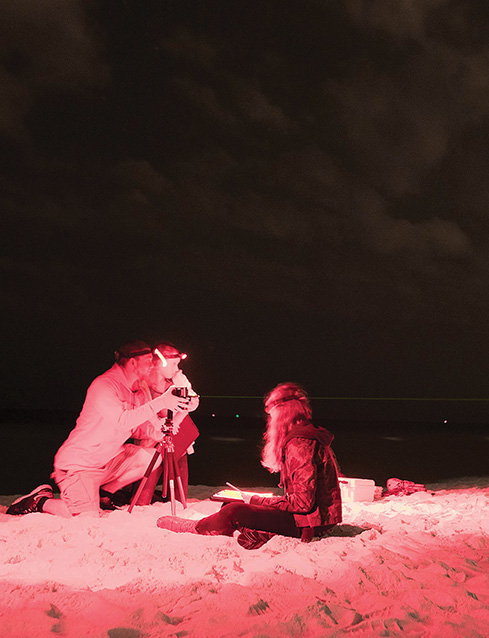It’s the first—and only—opportunity I’ve ever had to participate in real science data collection. We all feel empowered. Turtle T.H.i.S. student intern

NPS/Natural Sounds and Night Skies Division
A TEAM OF YOUTH VOLUNTEERS with Teens Helping in the Seashore, or “Turtle T.H.i.S.,” uses a photometer to measure ambient nighttime light levels near sea turtle nests at Gulf Islands National Seashore, Florida. The green laser beam helps the researchers target specific points for analysis. The red lights illuminating the work area are less disturbing to sea turtles and also preserve the team’s night vision because of their relatively short wavelength.
This program, which was formed in 2014 through a partnership with the National Park Foundation, the U.S. Geological Survey, and the NPS Natural Sounds and Night Skies Division, is part of a multifaceted sea turtle conservation effort along 160 miles (257 km) of undeveloped beaches that grace Gulf Islands. Four species of federally protected sea turtles nest at the park, including the loggerhead sea turtle (Caretta caretta), the green sea turtle (Chelonia mydas), the leatherback sea turtle (Dermochelys coriacea), and the Kemp’s Ridley sea turtle (Lepidochelys kempii).
The goals of the project are to (1) document night sky brightness, which is one of the primary factors having a direct impact on sea turtle nesting, hatchling disorientation, and hatchling survival; (2) have students learn about the ecology of nesting and hatching sea turtles; and (3) provide NPS managers and community leaders with data to make relevant, science-based management decisions for the conservation of nesting sea turtles.
The project engages approximately 200 youth from local schools and colleges—including these students from Escambia High School in Pensacola, Florida—to help with data collection, management, analysis, and outreach. This photograph captures in an instant just how deeply the Turtle T.H.i.S. project engages the volunteers. Another student intern (not shown) reflected on the program, saying, “It’s the first—and only—opportunity I’ve ever had to participate in real science data collection. We all feel empowered.”
Download: PDF of this article
This article published
Online: 6 May 2016; In print: 25 March 2016
URL
https://www.nps.gov/ParkScience/articles/parkscience32_2_79_shelley_3845.htm
Suggested citation
Shelley, D. C. 2016. Turtle T.H.i.S., Gulf Island National Seashore: 19 October 2014, 1:12 a.m. Park Science 32(2):79.
This page updated
5 May 2016
Site navigation
• Back to Volume 32, Number 2
• Back to Park Science home page
Last updated: March 21, 2021
